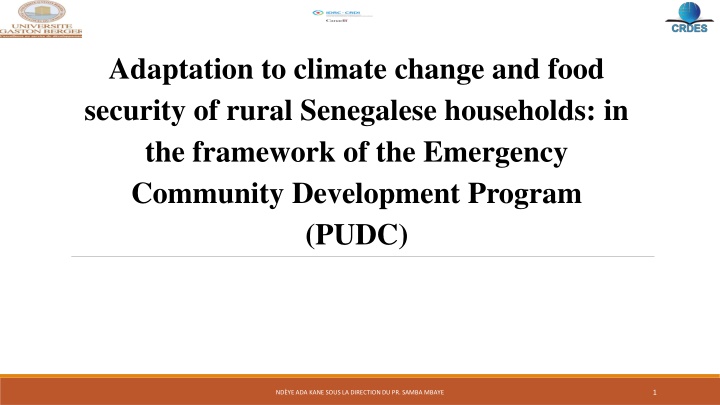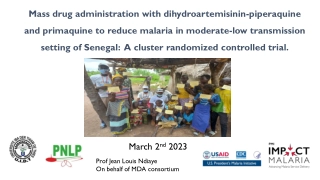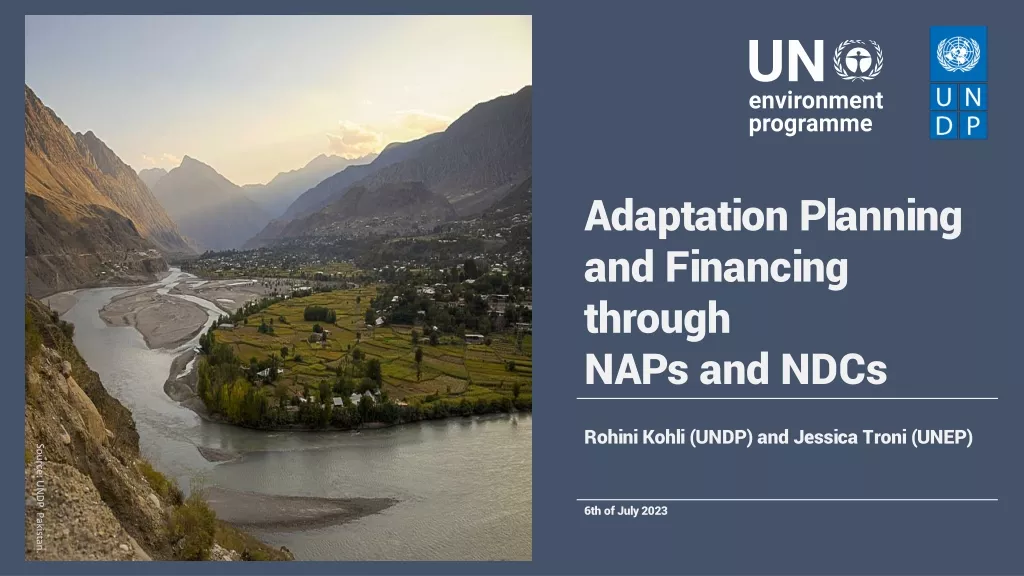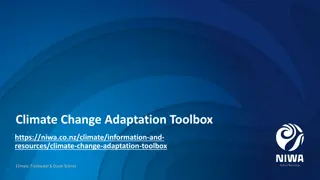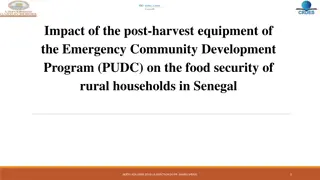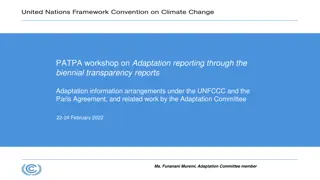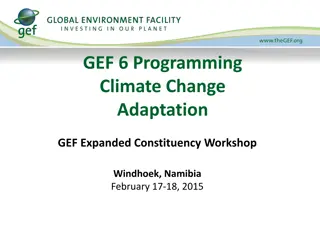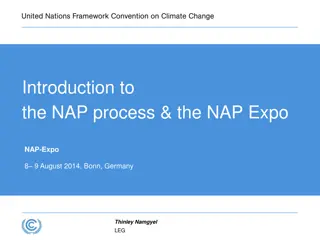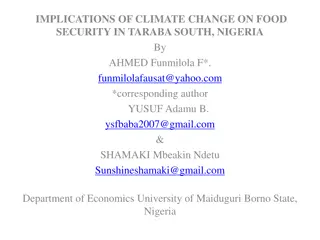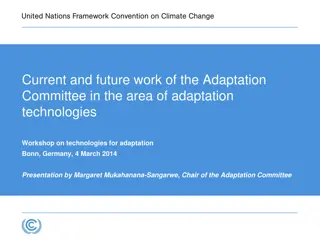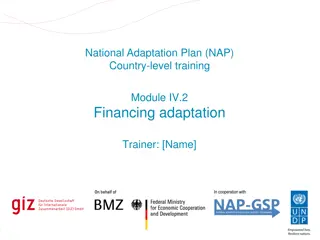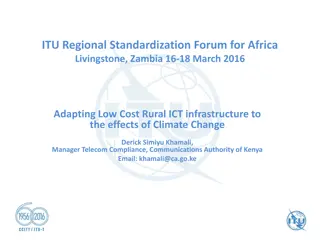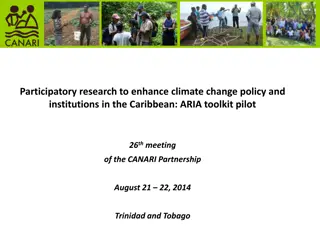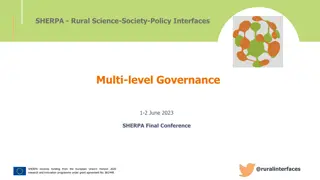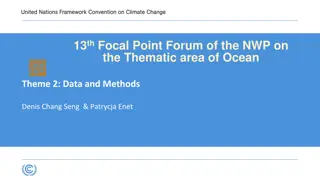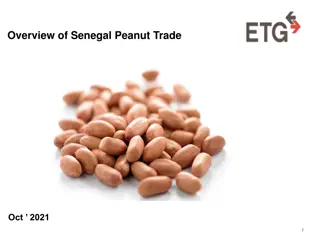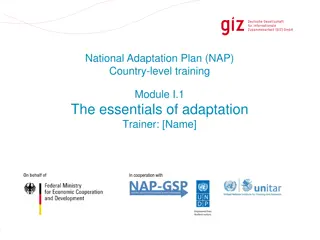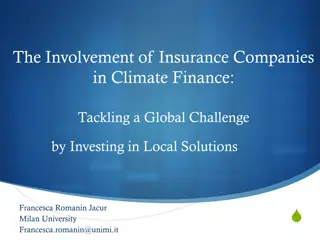Climate Change Adaptation and Food Security in Rural Senegal
The study explores the impacts of climate change on food security in Senegal, particularly focusing on adaptation strategies and their effects on rural households. It aims to analyze the determinants of adaptation techniques adopted by farm households and study how these adaptations have influenced food security in the country.
Download Presentation

Please find below an Image/Link to download the presentation.
The content on the website is provided AS IS for your information and personal use only. It may not be sold, licensed, or shared on other websites without obtaining consent from the author.If you encounter any issues during the download, it is possible that the publisher has removed the file from their server.
You are allowed to download the files provided on this website for personal or commercial use, subject to the condition that they are used lawfully. All files are the property of their respective owners.
The content on the website is provided AS IS for your information and personal use only. It may not be sold, licensed, or shared on other websites without obtaining consent from the author.
E N D
Presentation Transcript
Adaptation to climate change and food security of rural Senegalese households: in the framework of the Emergency Community Development Program (PUDC) 1 ND YE ADA KANE SOUS LA DIRECTION DU PR. SAMBA MBAYE
Outline Introduction Methodology Results Conclusion ND YE ADA KANE SOUS LA DIRECTION DU PR. SAMBA MBAYE 2
Introduction The economy of Senegal, like the economies of other sub-Saharan countries, is mainly based on agriculture. Indeed we note that: this sector employs more than 60% of the active population (PSE 2014) while its contribution to the Gross Domestic Product is only 15% in 2018 (World Bank2018) Among the factors that explain this low contribution of the agricultural sector is climate change. For the last thirty years, the climate has been manifested mainly by an increase in extreme climatic events such as droughts and droughts and meteorological, and a variability in the length of rainy seasons, and even thermal seasons. (Gaye, Lo, Djimbyra, Fall, & Ndiaye, 2015) Taylor et al. ( 2019), climate change negatively affects all components of food security, namely availability, access, utilization and stability through the decrease in agricultural yields, reducing food intake by limiting the content, variety and frequency of daily meals (FAO, 2008a ; Thorlakson & Neufeldt, 2012 ; Harvey et al., 2014) ; a decrease in the nutritional quality of the seeds (Kettlewell, Sothern, and Koukkari , 1999); an outbreak of food-borne diseases through microbiological contamination of food (Tirado et al. (2010) 3 ND YE ADA KANE SOUS LA DIRECTION DU PR. SAMBA MBAYE
Introduction In Senegal, one person in six is food insecure (AVGSAN, 2014). the 2021 report of the global food security index ranks Senegal 89th out of 113 countries and gives it a score of 47.4 out of 100, not even reaching the average. and climate change is among the most important factors in this situation. So it is normal that people find ways to protect themselves from the harmful consequences of climate change and farm households are experimenting with several climate change adaptation techniques, In addition, some programs such as PUDC, in its implementation, has helped farm households to adapt to climate change by providing them with training in this context. In view of all this, we feel it is important to look more closely at the link between climate change adaptation strategies and food security indicators. but also to deepen the analysis on the determinants of adaptation to climate change in Senegal 4 ND YE ADA KANE SOUS LA DIRECTION DU PR. SAMBA MBAYE
Introduction Main ojective: but also to deepen the analysis on the determinants of adaptation to climate change in Senegal Sp cifics objectives 1. Analyse the determinants of adaptation techniques adopted by farm households ; 2. study how adaptation has impacted the food security of rural households Contribution of this research Most research in Senegal has been limited to the impacts of climate change on food security, and the objective of this paper is to go beyond this by focusing on the determinants of adaptation in Senegal and its impact on the country's food security 5 ND YE ADA KANE SOUS LA DIRECTION DU PR. SAMBA MBAYE
Methodology The study area is located in Senegal, a West African state that covers an area of 196,722 km2 and lies between 12 8 and 16 09 north latitude and 12 and 17 west longitude. It is a Sudano-Sahelian country composed of fourteen (14) administrative regions, with few rivers and regularly hit by rainfall deficits. There are six agro-ecological zones: the groundnut basin, the Casamance, the Niayes, Eastern Senegal, the river valley and the sylvopastoral zone. 88% of the households studied in this article, are located in the groundnut basin and the remaining 12% are in the river valley area. The groundnut basin is composed of five (05) regions including Thies, Louga, Diourbel, Fatick, and Kaolack. It is the leading agricultural region in Senegal (BIGNEBAT & SAKHO-JIMBIRA, 2013). The data comes from two surveys conducted by the Center for Research in Development (CRDES) on the PUDC in 2016 and 2020 Economic and Social 6 ND YE ADA KANE SOUS LA DIRECTION DU PR. SAMBA MBAYE
Methodology To find the determinants of coping strategies a panel logistic model was applied on the data The logistic regression model in panel data is given by the following formula: = ? + ????+ ????; ???? where the latent (underlying) variable that determines whether farm household j would be classified as an ???? adopter of CCA measure i at time t; ? a vector coefficient; ???a matrix of explanatory variables; a is the constant term; and ???? the idiosyncratic errors. yijtand the observed outcom is represented as: The relationship between the latent variable ???? ????= 1 ?? ???? 0 ?? ???? = ? = 0for all i=1 to n and all j from 1 to p-1 ????= 1 if a farm household adopts a CCA strategy for each adaptation strategy 7 ND YE ADA KANE SOUS LA DIRECTION DU PR. SAMBA MBAYE
Methodology To assess the impact of climate change adaptation strategies, the PSM and DID models are combined. Let T be our treatment variable which is climate change adaptation for a given household. The variable T is given by the following formula: ? = 1 ?? ?? ? ???? ? ?????? 0 ????? Let X= (X1 , X2, ......., Xk) be a vector of observable characteristics, then the PSM can be formulated by the following formula: ? ? = ? ? = 1/? = ? 1/? 8 ND YE ADA KANE SOUS LA DIRECTION DU PR. SAMBA MBAYE
Methodology After matching, a panel was formed to account for the years 2016 and 2020 and the double-difference method was applied to determine the impact of climate change adaptation on food security variables. This method, compared to the PSM, assumes that there is unobserved heterogeneity in adaptation but that these factors are time invariant. ? ??0 ? ? ??0 ? ? ??(?,?) ??1 ??? = ??1 w (i, j) is the weight (using a PSM approach) given to the jth control area matched to the adoption area I ?outcome variable for farm households that have adapted to climate change in ??? t={2016, 2020} ?outcome variable for farm households that have not adapted to climate change in ??? t={2016, 2020} 9 ND YE ADA KANE SOUS LA DIRECTION DU PR. SAMBA MBAYE
Methodology The treatment variable is climate change adaptation, which is a binary variable that equals zero (0) if the household does not adapt to climate change and 1 if it does. The food security variables used in this research are: agricultural production in kg, the existence or not of a hunger gap, and meal skipping during the hunger gap. Climate change is considered in this study through the climate hazards that most affect the farmland of the sampled households. These are mainly drought, flooding, insect pests and wind erosion. variables referring to the socio-economic characteristics of the head of the household have been taken into account in the economic literature variables that relate to the household as a whole such as access to credit, ownership of agricultural land, participation in a climate change risk education program, and household size Some variables are related to agricultural production. 10 ND YE ADA KANE SOUS LA DIRECTION DU PR. SAMBA MBAYE
Results 11 ND YE ADA KANE SOUS LA DIRECTION DU PR. SAMBA MBAYE
Table 1: Changes in descriptive statistics in 2016 and 2020 Variables Modalities 2016 2020 Variation Percentage Mean Percentage Mean Outcomes total production of crop 2100,4 3221,2 53% -25,23 25,23 -8,44 8,44 Oui Non Oui Non 50,7 49,3 15,89 84,11 25,47 74,53 7,45 92,55 existence of a hunger period meal skip Household head characteristics age male 52 55 6% 0,82 -0,82 -1,8 1,8 -0,33 0,33 -17,2 17,2 5,08 -5,08 4% F minin Masculin Oui Non Oui Non Oui Non Oui Non 3,44 96,56 10,4 89,6 95,5 4,5 57,33 42,67 41,03 58,97 4,26 95,74 8,6 91,4 95,17 4,83 40,13 59,87 46,11 53,89 literacy married off_farmjob accesscredit size Assets machinery 13 13,5 Oui Non Oui Non Oui Non Oui Non 1,97 98,03 97,87 2,13 83,37 16,63 6,22 93,78 0,74 99,26 99,92 0,08 84,6 15,4 7,78 92,22 -1,23 1,23 2,05 -2,05 1,23 -1,23 1,56 -1,56 animals terre training Climate Oui Non Oui Non Oui Non Oui Non 28.09 71.91 14.41 85.59 60.69 39.31 17.61 82.39 58.15 41.85 30.96 69.04 24.08 75.92 4.10 95.90 30,06 -30,06 16,55 -16,55 -36,61 36,61 -13,51 13,51 Drought Flood Pests Wind_erosion Input fertilizers manure Labor Income off farm income agricultural income total income 189,5 691 6,8 449,9 209,8 5,9 137% -70% -13% 311301 338296 682784 437710 344119 719225 41% 2% 5% 12 ND YE ADA KANE SOUS LA DIRECTION DU PR. SAMBA MBAYE
Table 2: Determinants of adaptation to climate change adaptation VARIABLES coefficients 6.730***(0.965) 4.309*** (0.944) 5.242*** (0.870) -3.330*** (0.908) -0.0387 (0.0365) 3.090*** (0.792) -0.437 (1.494) -1.861** (0.917) 0.0143 (0.0205) -1.118 (0.747) -3.617*** (1.087) 0.00495 (0.645) 1.17e-06 (1.42e-06) 1.92e-06 (1.31e-06) -9.44e-07 (1.02e-06) 0.897 (1.111) -1.428* (0.866) 0.0865 (0.860) 0.850 (1.071) 1.048 (1.159) 6.694*** (2.205) odds ratio 837.1*** (807.6) 74.34*** (70.19) 189.0*** (164.5) 0.0358***(0.0325) 0.962 (0.0351) 21.98*** (17.40) 0.646 (0.965) 0.156** (0.143) 1.014 (0.0208) 0.327 (0.244) 0.0269*** (0.0292) 1.005 (0.649) 1.000 (1.42e-06) 1.000 (1.31e-06) 1.000 (1.02e-06) 2.451 (2.722) 0.240* (0.208) 1.090 (0.938) 2.339 (2.505) 2.853 (3.307) 807.4*** (1,780) drought (yes=1) flood (yes=1) pests (yes=1) wind_erosion (yes=1) size accesscredit (yes=1) married (yes=1) literacy (yes=1) age off_farmjob (yes=1) training (yes=1) landlord (yes=1) off farm income agricultural income total_income Fatick Kaffrine Kaolack Louga Saint Louis Thi s likelihood ratio LR chi2(21) p-Value Observations Standard errors in parentheses *** p<0.01, ** p<0.05, * p<0.1 368.41*** 0.0000 1340 1340 13 ND YE ADA KANE SOUS LA DIRECTION DU PR. SAMBA MBAYE
Table 3: Variable balancing table Variable(s) Total production drought flood pests wind_erosion size accesscredit married literacy male age off_farmjob training machinery animals labor fertilizers manure land Off farm income Agricultural income total_income Hunger season Meal skip Mean Control 2144.651 0.360 0.163 0.547 0.163 13.198 0.407 0.930 0.116 0.965 51.547 0.512 0.105 0.035 1.000 6.977 178.744 670.035 0.814 2.6e+05 2.2e+05 5.5e+05 0.477 0.174 Mean Treated 1933.151 0.288 0.142 0.623 0.164 12.906 0.438 0.955 0.111 0.973 52.200 0.580 0.029 0.022 0.978 6.923 186.531 690.861 0.830 3.3e+05 2.4e+05 6.3e+05 0.507 0.149 Diff. -211.500 -0.073 -0.021 0.077 0.002 -0.292 0.031 0.025 -0.005 0.007 0.654 0.069 -0.076 -0.013 -0.022 -0.054 7.787 20.826 0.017 7.1e+04 1.5e+04 8.1e+04 0.030 -0.025 t 1.00 1.24 0.61 1.53 0.03 0.70 1.04 0.67 0.13 0.33 0.70 1.05 1.94 0.50 4.37 0.21 0.70 0.38 0.31 1.72 0.57 1.90 0.36 0.56 Pr(T>t) 0.3558 0.2616 0.5664 0.1776 0.9768 0.5122 0.3393 0.5258 0.9011 0.7517 0.5097 0.3338 0.0999* 0.6334 0.0047*** 0.8378 0.5094 0.7155 0.7681 0.1365 0.5886 0.1057 0.7284 0.5973 14 ND YE ADA KANE SOUS LA DIRECTION DU PR. SAMBA MBAYE
Tableau 4 : Impact of climate change adaptation on agricultural production VARIABLES temps adaptation impact drought flood pests wind_ero size accesscredit married literacy male Age off_farmjob machinery animals labor fertilizers manure terre training Constant Effets fixes Observations R-squared Standard errors in parentheses *** p<0.01, ** p<0.05, * p<0.1 totalcrop 282.7 (394.9) -211.5 (299.1) 1,418*** (423.0) totalcrop 282.7 (450.4 -211.5 (211.5) 1,418*** (310.2) totalcrop -804.0 (434.7) -260.5 (203.6) 1,630*** (291.6) -268.7*** (71.58) -147.5 (151.9) 178.9 (92.35) 17.07 (317.7) 23.70* (11.56) -86.07 (111.6) 167.2 (114.9) 74.48 (197.0) 84.98 (420.2) 13.99*** (2.212) 47.91 (80.56) -320.8 825.7*** (144.2) 116.2*** (21.08) 4.239*** (0.511) 0.0282 (0.114) -8.576 (185.1) 99.99 (283.2) -1,510** (559.5) Oui 1340 0.282 2,145*** (279.2) Non 1340 0.090 2,145*** (263.2) Oui 1340 0.090 15 ND YE ADA KANE SOUS LA DIRECTION DU PR. SAMBA MBAYE
Table 5: Impact of climate change adaptation on the existence of lean periods and meal skips Variables Hunger period Meal skip temps 0.0581 (0.0573) 0.0581 (0.0825) 0.0279 (0.0832) -0.0465 (0.0409) -0.0465 (0.0748) -0.0388 (0.0715) adaptation 0.0301 (0.0434 0.0301 (0.0828) 0.0312 (0.0799) -0.0254 (0.0310) -0.0254 (0.0456) -0.0164 (0.0403) impact -0.565*** (0.0614) -0.565*** (0.0706) -0.624*** (0.0784) -0.102** (0.0438) -0.102* (0.0492) -0.120* (0.0593) Effets fixes Non Oui Oui Non Oui Oui Covariables Non Non Oui Non Non Oui Observations 1340 1340 1340 1340 1340 1340 R-squared 0.310 0.310 0.324 0.072 0.072 0.085 Standard errors in parentheses *** p<0.01, ** p<0.05, * p<0.1 16 ND YE ADA KANE SOUS LA DIRECTION DU PR. SAMBA MBAYE
Conclusion At the end of the analysis, it was found that variables related to climatic hazards such as droughts, floods, and insect pests positively and significantly influence the probability of adaptation to climate change by rural agricultural households. Other positive determinants of climate change adaptation include the variable on access to credit and whether a given household resides in the Thi s region compared to the Diourbel region. On the other hand, the variables on training in climate change adaptation, living in the Kaffrine region compared to the Diourbel region, and education have highly significant but negative coefficients. This means that these variables negatively influence the probability of adaptation to climate change by agricultural households. Adaptation to climate change has a very significant positive impact on agricultural production and a very significant negative impact on the existence or not of the hunger gap. In other words, adaptation to climate change has increased agricultural production in the sampled households and reduced the existence of the hunger gap in households. In addition, adaptation to climate change has also led to a reduction in meal skipping within agricultural households 17 ND YE ADA KANE SOUS LA DIRECTION DU PR. SAMBA MBAYE
Conclusion Adaptation also has an impact on food security through its availability and access components, and the PUDC, by helping agricultural households to protect themselves and adapt to the risks associated with climate change, has indirectly improved the food security of agricultural households in rural areas. economic policy implications Invest more in programs that will help households adapt to climate change, To provide households with adequate agricultural technology packages taking into account the climate change observed in the different ecologies and agricultural systems of the country. To provide farm households with specific training programs on climate change adaptation that meet their needs; this could have a positive impact on their adaptation decision. To further strengthen access to climate data information and its dissemination in rural areas. To reverse the trend in the use of fertilizers by encouraging the population to favor organic fertilizer over chemical fertilizer in order to have healthier food and thus reduce greenhouse gas emissions which are mainly responsible for all these climate changes. And strengthen targeted food safety nets and agricultural subsidy programs for the poorest farm households 18 ND YE ADA KANE SOUS LA DIRECTION DU PR. SAMBA MBAYE
Thank you for your interest 19 ND YE ADA KANE SOUS LA DIRECTION DU PR. SAMBA MBAYE
